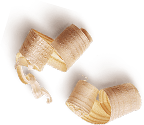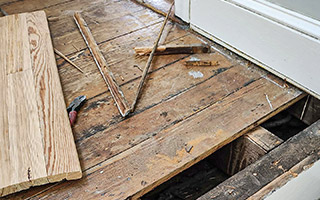

How to Fix Squeaky Floorboards: Causes, Solutions and When to Call a Pro
Squeaky floorboards may seem like a minor nuisance, but they often signal deeper structural issues that shouldn't be ignored. Whether it's a persistent creak under a hallway rug or an annoying squeak near your bed, these sounds can quickly become part of your daily frustration.
The good news? Fixing squeaky floors doesn't always require major renovations or a hefty investment. In this guide, we'll explain what causes floorboards to squeak, offer practical solutions, and help you decide when it's time to call in a flooring professional, especially if you're in Northern Virginia, Washington D.C., or Maryland.
What Causes Squeaky Floorboards
Squeaks happen when there's movement or friction between parts of your flooring system. Common causes include:
- Wood Shrinkage or Swelling: Seasonal humidity changes cause boards to expand and contract, creating friction.
- Loose Fasteners: Nails or screws that no longer hold tightly allow floorboards to shift.
- Gaps Between Subfloor and Joists: Voids or uneven installation let boards flex and rub under pressure.
- Poor Subfloor Installation: Inadequate materials or methods lead to instability and noise.
- Joist Problems: Wide spacing, uneven joists, or lack of blocking can all lead to excess flex and squeaks.
How To Fix Squeaky Floorboards
While some minor issues can be addressed with simple techniques, others require professional repair. Here are common solutions:
- Lubricate Minor Gaps: Use powdered graphite, talcum powder, or dry lubricant to reduce friction between boards.
- Tighten Loose Boards: Replace nails with screws and secure boards into joists if accessible.
- Add Shims or Packers: Insert glue-coated wood shims between joists and subfloor where there's movement.
- Apply Adhesive: Inject construction adhesive into long seams or gaps to stabilize floorboards.
- Reinforce Joists or Subfloor: For deeper problems, additional blocking or subfloor repairs may be needed.
- Control Indoor Humidity: Keep levels between 35 and 55 percent to prevent seasonal wood movement and future squeaks.
When To Call A Flooring Professional
DIY fixes may work for minor squeaks, but in many cases, a trained technician is your best bet. Contact a pro if:
- Squeaks persist after trying several home fixes
- Floors show structural signs, like sagging, bouncing, water damage, or visible gaps
- You have antique or high-value hardwood that could be damaged by improper repairs
- Squeaks come from hard-to-reach areas, like stairs, under built-ins, or above finished ceilings
- The issue spans multiple rooms, suggesting a systemic subfloor or joist problem
- The cause is unclear, and both floorboards and subfloor may be involved
Why Trust A Professional Floor Repair Service Like Hardwood Revival?
- Expert Diagnosis: We identify the true cause, cosmetic or structural.
- Specialized Tools And Products: We use professional-grade materials for clean, durable results.
- Efficient Long-Term Fixes: We handle repairs quickly, often with a warranty.
- Comprehensive Repairs: We can also address water damage, joist issues, or subfloor replacement if needed.
If you're in Northern Virginia, D.C., or Maryland, the experts at Hardwood Revival can help diagnose and fix squeaky floors quickly and cleanly.
How To Prevent Squeaky Floors In The Future
- Control Humidity: Maintain indoor levels between 35 and 55 percent to prevent wood expansion and contraction.
- Quality Installation: Use kiln-dried wood, sturdy subflooring, and professional-grade fasteners.
- Secure Boards Properly: Use screws instead of nails and fix any loose planks immediately.
- Minimize Moisture: Clean floors with dry or slightly damp methods and fix leaks promptly.
- Install Underlayment: For new floors, a quality underlayment helps prevent friction and noise.
Need Help Fixing Squeaky Floorboards
Don't let squeaky floors drive you crazy. If you're located in Northern Virginia, Washington D.C., or Maryland, Hardwood Revival offers expert repair services to eliminate squeaks and restore your hardwood floors.
Frequently Asked Questions
Is Squeaking A Sign Of Damage?
Squeaky floors don't always signal major damage, but they often point to hidden structural or installation concerns.
Will Repairing The Squeak Damage My Hardwood Floor?
Proper squeak repair is designed to preserve your hardwood, not harm it. Most methods, like tightening loose boards, applying adhesive from below, or using trim screws are minimally invasive and can be done without affecting the finish or integrity of the wood.
Do Engineered Wood Or Laminate Floors Squeak Too?
Yes, engineered and laminate floors can squeak especially if they were improperly installed or have subfloor issues.

